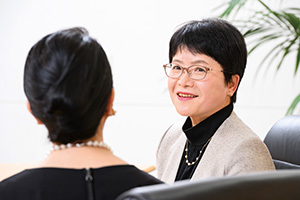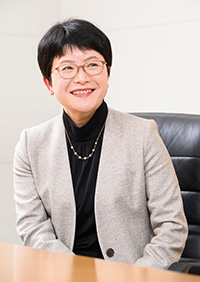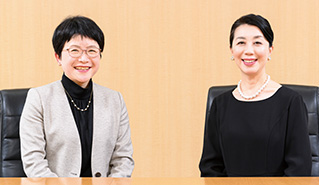 |
|
|
|
|
|
View from the Top Vol. 22, No. 5, pp. 1–5, May 2024. https://doi.org/10.53829/ntr202405tp1
Pursuing Triple Win for Us, Partners, and Society and Trying Our Best to Live in the PresentAbstractNTT Information Network Laboratory Group promotes research and development (R&D) of communication networks and innovative environmental and energy technologies to create a sustainable and prosperous society. Focusing on three pillars of the Innovative Optical and Wireless Network (IOWN), robust networks, and environment and energy, the laboratory group aims to contribute to building a sustainable infrastructure of an information society and provide new value. We asked Yukari Tsuji, senior vice president, head of NTT Information Network Laboratory Group, about the laboratory group’s R&D strategy and her mindset as a top executive. Keywords: IOWN, sustainability, R&D management Creating a sustainable infrastructure for an information society—What is the mission of NTT Information Network Laboratory Group? Our mission is to provide new value by building a sustainable infrastructure of an information society that connects everything. When people hear the word “sustainable” or “sustainability,” many may think of environmental measures such as decarbonization, but we think “sustainability” has a much deeper meaning than that. I will explain the sustainability that we are aiming for in terms of our three pillars of research and development (R&D), i.e., the Innovative Optical and Wireless Network (IOWN), robust networks, and environment and energy. Regarding the first pillar, IOWN, we aim to develop ultra-high-speed, low-latency, low-power-consumption networks. It is obvious that the amount of communication traffic and information handled by datacenters will increase exponentially with the advancement of the data-driven society and evolution and popularization of artificial intelligence (AI) as represented by generative AI. As this trend continues, power consumption will become a serious social problem. IOWN will be able to reduce power consumption. It will also enable local production for local consumption of data and power by connecting datacenters and edges via the All-Photonics Network (APN). If many users can use a variety of services and solutions simultaneously within IOWN, additional social costs will be kept as low as possible, even as the numbers of use cases and users increase. The second pillar, robust networks, is a key element in achieving sustainability in the sense that a communication network can continue to be used under any circumstances. To minimize damage and impact due to disasters and failures, it is necessary to increase network resilience. To this end, we are steadily advancing R&D on visualization of network status and the impact of disasters and failures on services. Additionally, technologies for zero-touch operation minimize operator involvement in network operations, which will also play a key role as countermeasures against the future decline in the workforce. The third pillar, environment and energy, is not hard to imagine. Aiming to achieve both economic growth and zero environmental impact, we are researching proactive sustainability technologies, such as energy creation, and developing technologies for global environmental observation and forecasting that will enable a society to adapt to the changing environment. For example, if extreme weather events such as typhoons and linear rain bands could be predicted promptly and with high accuracy, it would be possible to take countermeasures proactively, which would also contribute to building robust networks. We thus view “sustainability” from multiple perspectives and aim to create a truly sustainable infrastructure of an information society through our above-described R&D.
—I understand that R&D from various perspectives is necessary to create a sustainable infrastructure of an information society. What kind of lineup does NTT Information Network Laboratory Group have in place to conduct such R&D? NTT Information Network Laboratory Group consists of three laboratories: NTT Network Service Systems Laboratories, NTT Access Network Service Systems Laboratories, and NTT Space Environment and Energy Laboratories. NTT Network Service Systems Laboratories is researching and developing infrastructure technologies that support network architectures and network systems for future network services as well as technologies for communication-traffic control, quality management, and network operations. NTT Access Network Service Systems Laboratories is researching and developing wireless access, optical-fiber access, access infrastructure, and related operation technologies to create a smart society. NTT Space Environment and Energy Laboratories is researching technologies for creating overwhelmingly clean next-generation energy and reducing environmental impact by predicting the future of the global environment and society and helping society to adapt to the environment. I consider it very important that these three laboratories belong to NTT Information Network Laboratory Group. As I mentioned earlier, to build a sustainable infrastructure of an information society and make it useful to society, it is necessary to consistently consider network as well as environmental and energy aspects and obtain their synergistic effects. To break through the limitations of conventional technologies and create a prosperous society, we take pride in our daily R&D work while collaborating with researchers and business partners in Japan and abroad in a manner that enables us to chart a course for practical implementation of our research results in society.
Creating an environment in which researchers with different capabilities can interact with each other—Would you tell us about the R&D that you are focusing on? Our current major goal is to establish technologies and commercialize business to make IOWN easier for more users to use. NTT Information Network Laboratory Group is particularly involved in developing the APN, a component of IOWN. Our goal is to provide an environment in which users can use optical paths for a variety of use cases, whenever they want to use them, in the amount they need, and with the quality appropriate for their usage. To reach this goal, we are developing technologies to provide end-to-end optical paths. For example, we developed the Photonic Gateway, which aggregates various user equipment with low latency and the Photonic Exchange, which can connect networks with different types of optical fiber. We are also researching and developing controllers for controlling the APN according to user requirements. We are also investigating next-generation network architecture and operations. For example, we intend to create flexible service experiences that are not limited by user environment, terminal equipment, or service. To achieve this, the key technology of networks is to coordinate and speed-up information processing between terminal equipment and the cloud anytime and anywhere. Regarding wireless communications, in addition to increasing capacity and reducing latency, we are researching and developing proactive wireless-control technologies that adapt to changes in the wireless environment and technologies to extend wireless coverage to unexplored areas by using non-terrestrial networks. —How is your R&D progressing? Could you tell us about some creative ways to promote R&D? We are making good progress despite some difficulties. IOWN was initially targeted for implementation in 2030, but IOWN APN1.0, a leased line service, was launched in March 2023. After unveiling our latest technology at Expo 2025 Osaka, Kansai, Japan, we will gradually roll out full-scale and on-demand IOWN services. Since the concept of IOWN was announced in 2019, NTT Information Network Laboratory Group has been studying the specifics of the concept and preparing various technologies, and the fiscal year 2024 is an important year for creating a path toward the deployment of these technologies in business. To clarify when and in what form each technology should be deployed to achieve our goals in accordance with our roadmap, it is necessary to bring together the knowledge of various players and combine our collective strengths. We therefore called on key members from multiple related departments and research laboratories and set up a venue for cross-technical and cross-disciplinary discussions, in which I also participate. Rather than just responding to reports, I listen to the multifaceted opinions of a wide range of participating members, which adds depth to discussions and increases a sense of reality. Through these activities, I have seen a change in mindset among members to one in which everyone is willing to work together across organizations and feel that the speed and depth of our R&D have increased. To foster such a climate of open-minded cooperation, as the head of NTT Information Network Laboratory Group, I intend to create a work environment in which our researchers can make the most of their individual talents. We have researchers who use cutting-edge technology to produce “world’s firsts” or “record-high performance,” researchers who think about network architecture, and researchers who are very good at engineering ingenuity. I believe that having such researchers with various specialized skills is an important asset. An open work environment is a key factor in enabling each one of us to make use of their unique characteristics and demonstrate their abilities with confidence. With that in mind, I opened a chat room called “Yukari’s Room” on our internal information-sharing tool so I could start to get members of our laboratory group to know me. Every day, I post short messages about how I’m feeling and what I’m thinking, and when I shared about having this interview, I received a series of supportive marks from the members. Therefore, an atmosphere of mutual interaction is being created.
What looks like failure is a process to success in which you confirmed that the method does not work—It has been more than a year since you assumed current position. How are you feeling? Every day is much more enjoyable than I imagined. I suppose that it is partly because of my own way of looking at things. I think it is also because our members are enthusiastically working on a very wide range of technologies, and I’m able to exchange ideas with them on a variety of issues on a daily basis. To be honest, before I assumed my current position, I was a little worried about whether the research laboratories that I was returning to after a long time away would be full of energy and whether the researchers would be friendly toward me, but my fears turned out to be completely unfounded. However, I sometimes think that because we are a group of very talented researchers, we might focus too much on fulfilling our own and our team’s responsibilities and respecting the activities of others and other teams, thus confine ourselves to the areas of our responsibilities. To dispel this mindset, as I mentioned above, we are working to create an open atmosphere so that all parties can step in and discuss things a little at a time and to work in a cross-organizational manner. We are working to fill gaps not only within our laboratory group but also with other NTT research laboratories and operating companies, and I think things have started to turn in the right direction over the past year. Fiscal year 2024 will be a year of major shifts in the implementation phase of IOWN, so I want us to proceed with thorough consideration so that IOWN can be used by many customers. —Finally, could you give a message to our researchers and engineers as well as our customers and partners? First, to our researchers and engineers. Many things that “look like failure” will happen in the course of your research. I’ve also experienced such “failures.” However, you might think of it as a “failure” because you just have decided so yourself. What looks like “failure” is the result of having confirmed that the method you used doesn’t work for a certain purpose, but a different method might work if you try it. Therefore, what seemed like a “failure” is in fact a “process to success.” With this way of thinking in mind, you should not be afraid of taking on challenges. I want you to approach R&D with the mindset of trying things out, saying, “If this method doesn’t work, I’ll just try another method.” As a message to our customers and partners, we want to create a sustainable infrastructure of an information society. To that end, we want to establish an ecosystem in which our R&D results are incorporated and strive for a situation in which we, our customers and partners, and society all win. Let’s build a great future together. My job as top management is to provide direction and to make the right decisions on a case-by-case basis. For that reason, I strive to keep my mind and body always in a stable state. Behind this attitude are the lessons I learned through team sports, which I have been involved in since childhood. I have been playing basketball since my school days, and I noticed players who each had their own special skills honed their individual skills then combined their skills with those of others to gain even more power for the team. When I took up hot-air ballooning at university, I learned firsthand that there are things, such as the weather and other balloons, I cannot control. There’s no point in worrying much about things I cannot control, therefore, I started thinking that I should stop worrying about things I cannot control and focus on what I can control. That is how I arrived at the word jikon (only now), which is a Buddhist term. I interpret this term to mean that the only things that I can change are those concerning “now” and “me” and that since the past cannot be changed, we should try our best to live in the present. The term jikon is my motto. I think it would be ideal if we could be of service to society while enjoying the present to the fullest. Interviewee profileCareer highlightsYukari Tsuji joined NTT in 1989. She became director of the R&D Center at NTT WEST in 2014, vice president, head of NTT Network Technology Laboratories in 2016, board director, deputy general manager of Network Innovation Business Headquarters, and director of IOWN Business Promotion Office at NTT Advanced Technology in 2019, and general manager of IOWN Innovation Business Headquarters at NTT Advanced Technology in 2022. She has been in her current position since June 2023. |
|












